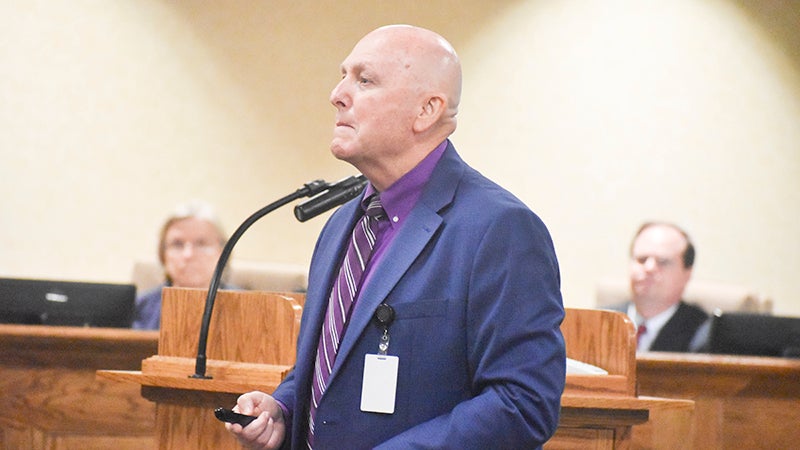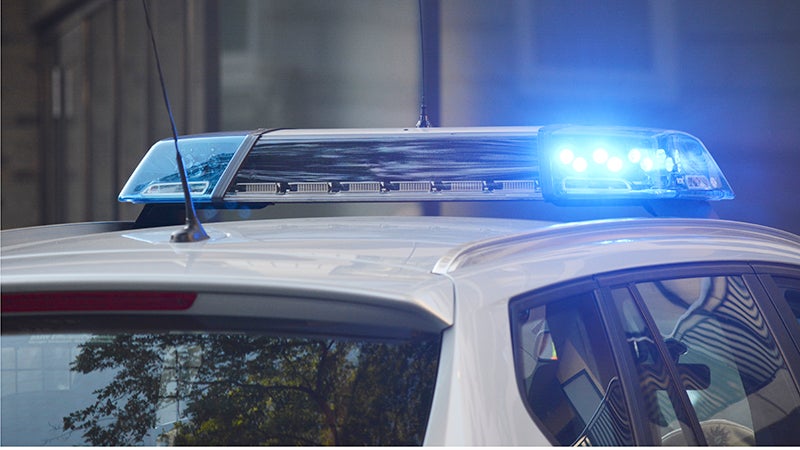TCSS schools are in constant “soft lockdown,” safety plan shows. School System wants to continue to “learn from mistakes” of nation’s mass shootings
Published 12:00 pm Saturday, June 18, 2022

- Steve Heaton, TCSS school safety coordinator, recounts the school system’s safety plan at the school board’s Thursday meeting. On Heaton’s jacket is a Centegix badge which can alert law enforcement in the event of an emergency.
|
Getting your Trinity Audio player ready...
|
School safety remains a priority for parents and school officials, especially following the Uvalde, Texas elementary school shooting where 19 children and two teachers were killed.
The Troup County School System has long-established a school safety plan, including fire drills and a hazardous weather plan, which are both required by the State of Georgia to be conducted throughout the school year.
Lockdown drills as well are not new to the school system and are conducted quarterly with the assistance of law enforcement.
“I think in the last two years we’ve made significant strides [in school safety],” said Assistant Superintendent Chip Medders.
”I think we’re getting better, and we’re learning from the mistakes we have seen nationally.”
Steve Heaton, TCSS school safety coordinator, is responsible for directing area law enforcement, public safety divisions and school staff with such drills. In light of recent events, security measures at area schools and school-related functions are continuing to be evaluated before the next school year, he said. Area schools of all calibers are in a constant “soft lockdown” to maintain student and personnel safety and staff are constantly advised to be ready for any situation.
On Thursday, Heaton updated the school board on TCSS’s safety plan and the adjustments that have been made in recent years to implement stronger safety precautions.
“It’s unfortunate we have to have this conversation, but it’s a necessary evil in the current climate,” said Heaton, who was hired as the school safety coordinator in 2020.
During lockdown drills, which simulate an intruder entering the school, law enforcement officers walk through the school and check doors to be sure they are locked, look in classrooms to make sure the lights are off and students and teachers are not visible and are quiet.
“They yell, scream and holler, they shake doors,” Heaton said, adding law enforcement gives feedback following the drills. “For the most part, I think we do a good job at [the drills,] but there’s still room for improvement and we’re going to continue to work with that.”
Safety site visits are completed once a year by law enforcement, emergency management and the fire departments.
These routine walk-through visits are performed at all Troup County Schools so officers can be familiar with the layout of each school and can interact with staff and students. Their presence in the schools, as noted in the safety plan, exists to deter potential threats. Law enforcement agents additionally check exits and entrances for blockages or weak spots.
“We heard on the news about the Texas school shooting how the shooter got into the school and that classrooms were open,” Heaton said. “We work constantly with our staff that they stay in a soft lockdown and the exterior doors are locked.”
Other recent precautions include the introduction of Centegix badges. With three clicks of the badges button, law enforcement officers and other necessary agents will be sent to the school sending the signal. Emergencies can expand to fires, intruders and student/teacher conflicts. Emergencies can expand to fires, intruders and student/teacher conflicts. The badges are issued to teachers each year and to substitute teachers upon entry to a school. The badges contain GPS technology and can be deactivated remotely if stolen.
UNDER CONSIDERATION
Looking ahead, Heaton suggested the implementation of additional school resource officers at elementary schools.
His suggestion would be to introduce at least 11 SROs, which could cost the school system $637,589, as noted in the school safety plan.
LaGrange, Hogansville, West Point Police Departments and Troup County Sheriff’s Office would provide the financial support for equipment, uniforms and benefits, the plan said.
Heaton additionally suggested implementing more metal detectors or weapon identification systems into each school — essentially two units per secondary school, one unit per elementary school.
The cost to purchase detectors or identification systems is approximately $4,500 to $6,000 per unit.
Staffing the detectors, which Heaton said would take at least 23 personnel, would cost approximately $40,000 per person, $920,000 combined.
“Safety isn’t cheap, but it’s completely needed,” Heaton said.
School board members voiced their thoughts on the ideas presented.
Board member Ferrell Blair voiced doubts on the metal detector’s functionality.
“I have a chunk of steel in my shoulder and when I walk through a metal detector, it doesn’t go off, but if I have one key in my pocket, it sets it off,” Blair said. “I’m concerned with how effective they are.”
Board Chairman Cathy Hunt inquired if, in an instant where hundreds to thousands of students have to be screened at one time, all students would be safely screened and still make it to their classes on time.
Heaton said under the right circumstances and with the doctors properly staffed, timely screening was possible. Noting Ferrell’s concerns, he said technology did have its faults but still remains sufficient.
“It’s technology, so it’s going to pick and choose,” Heaton said, adding most metal detectors can be adjusted for sensitivity.
Medders said the school system already has six metal detectors that are used primarily at sporting events. They are also used at Hope Academy and the Troup County Career Center. The school board noted it would consider the possibility of budgeting for more metal detectors and SROs in the future but doing so in the next school year would require a budget adjustment.
“We could pass a budget amendment and come back in July and get it started,” Superintendent Dr. Brian Shumate said.
“It doesn’t mean we’re going to have [11 SROs] by September, it’s probably going to be a few more in the fall and throughout the year.”




